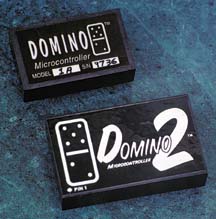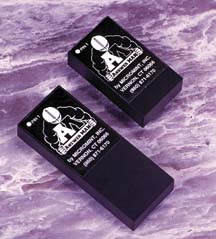|
| |
Embedded
Controller Modules |
Domino |
 Frequently Asked Questions
APPLICATION NOTES:
Using a
back-up battery for DOMINO-2’s RTClock/calendar
Taking advantage
of DOMINO's period input utility to measure distance using the sonar ranging module.
Adding a
DAC to the Domino – Connecting an LTC1257
2-channel, 12-bit DAC
Interfacing a
MAX232 Transceiver to theDomino Modules |
 The mighty Domino packs an 80C52 processor with a
full floating-point BASIC, 32-KB SRAM, 32-KB EEPROM, 12 parallel I/O bits, and a 2-channel
12-bit ADC in a 0.8-cubic-inch encapsulated package that consumes only 75 mW. The mighty Domino packs an 80C52 processor with a
full floating-point BASIC, 32-KB SRAM, 32-KB EEPROM, 12 parallel I/O bits, and a 2-channel
12-bit ADC in a 0.8-cubic-inch encapsulated package that consumes only 75 mW.
 Domino is fully RS-232A, RS-422, and RS-485 compatible without extra components.
Besides the two interrupts and three timers provided in the hardware, Domino is further
enhanced by firmware which delivers an I2C bus, two PWM outputs, and direct
period and frequency measurement. Domino is fully RS-232A, RS-422, and RS-485 compatible without extra components.
Besides the two interrupts and three timers provided in the hardware, Domino is further
enhanced by firmware which delivers an I2C bus, two PWM outputs, and direct
period and frequency measurement.
 Domino 2 has all the features of a Domino 1 plus an I/O coprocessor which adds 16
more bits of high-current parallel I/O, a hardware clock/calendar, wide-range power
operation, and a hardware PWM output. Domino 2 has all the features of a Domino 1 plus an I/O coprocessor which adds 16
more bits of high-current parallel I/O, a hardware clock/calendar, wide-range power
operation, and a hardware PWM output.
 Dominos can be programmed directly from a serial terminal without special
development tools. They can be programmed in either BASIC, a mixture of BASIC and assembly
language, or mostly assembly language with just an initial BASIC CALL statement. Programs
are initially developed in RAM and then transferred to the EEPROM for autostarting and
permanent storage. Dominos can be programmed directly from a serial terminal without special
development tools. They can be programmed in either BASIC, a mixture of BASIC and assembly
language, or mostly assembly language with just an initial BASIC CALL statement. Programs
are initially developed in RAM and then transferred to the EEPROM for autostarting and
permanent storage. |
| Data Sheets |
On-line |
PDF |
 |
| Domino 1 |
 |
 |
| Domino 2 |
 |
 |
PicStic |
 PicStic
Workshops:
Simple
Digital Output
Digital Input and Output
Program Flow
Data Stroage and Retrieval
Analog to Digital Conversion
Stepper Motor Control
Data Storting and LCD Output
Read and Writing to PC
Pulse Input
Memory Buffer |
 PicStic is a low-cost, industrially oriented controller on a
0.85-square-inch SIP (PicStics 1-3) or a DIP (PicStic4). Including options, PicStic
incorporates digital inputs and outputs, analog inputs, real-time monitoring, power-input
regulation, and serial communication (provided through software) in a single module.
PicStics can be used independently or networked together. PicStic is a low-cost, industrially oriented controller on a
0.85-square-inch SIP (PicStics 1-3) or a DIP (PicStic4). Including options, PicStic
incorporates digital inputs and outputs, analog inputs, real-time monitoring, power-input
regulation, and serial communication (provided through software) in a single module.
PicStics can be used independently or networked together.
 The basic PicStic offers both compatibility and improved performance. It comes in
four versions: PS1, PS2, PS3, and PS4. The PS1, PS2, and PS3 are all pin-compatible with
the Parallax BASIC Stamp I. The PicStic1 is a straight one-for-one programmable
replacement for the BS1. The basic PicStic offers both compatibility and improved performance. It comes in
four versions: PS1, PS2, PS3, and PS4. The PS1, PS2, and PS3 are all pin-compatible with
the Parallax BASIC Stamp I. The PicStic1 is a straight one-for-one programmable
replacement for the BS1.
 The PicStic2 has all the features of the PicStic1 plus a real-time clock/calendar
that keeps time in terms of the year, month, day of the month, day of the week, hour,
minute, and seconds. The clock always runs while the PicStic2 is powered. An optional 3-V
lithium battery maintains the clock when power is off. The battery, which is approximately
0.6 inches in diameter, can be mounted on the front or back of the PicStic2. The PicStic2 has all the features of the PicStic1 plus a real-time clock/calendar
that keeps time in terms of the year, month, day of the month, day of the week, hour,
minute, and seconds. The clock always runs while the PicStic2 is powered. An optional 3-V
lithium battery maintains the clock when power is off. The battery, which is approximately
0.6 inches in diameter, can be mounted on the front or back of the PicStic2.
 The PicStic3 has all the features of the PicStic1 plus a 2-channel, 12-bit ADC.
The compiler contains library routines for reading the ADC and real-time clock. The PicStic3 has all the features of the PicStic1 plus a 2-channel, 12-bit ADC.
The compiler contains library routines for reading the ADC and real-time clock.
 PicStic4 consists of a user-programmable controller, similar in most respects to
our original PicStic1, enhanced with an intelligent I/O coprocessor. The coprocessor
provides extended data memory, automatically reads and sets 12-bit analog I/O, reads or
sets the real-time clock, and supports up to 24 bits of additional parallel I/O. Beyond
the physical attributes, the coprocessor also provides numerous processing and data
management functions which can be accessed from the controller side. PicStic4 consists of a user-programmable controller, similar in most respects to
our original PicStic1, enhanced with an intelligent I/O coprocessor. The coprocessor
provides extended data memory, automatically reads and sets 12-bit analog I/O, reads or
sets the real-time clock, and supports up to 24 bits of additional parallel I/O. Beyond
the physical attributes, the coprocessor also provides numerous processing and data
management functions which can be accessed from the controller side.
 Complicated program tasks like scanning keypads, driving an LCD display,
recording Vmin, Vpeak, and Vavg analog readings, reading and setting the real-time clock,
recording important data in extended nonvolatile memory, totaling events, reading
frequency, generating a constant PWM output, or reading Dallas Semiconductor iButton
serial numbers, are all provided as simple callable functions from the I/O coprocessor.
PicStic4 is designed to provide the user with a cost-effective and easily programmable
control device without requiring the user to eat up valuable controller-side programming
space with all the low-level code typically necessary to perform useful monitoring and
control activities. Complicated program tasks like scanning keypads, driving an LCD display,
recording Vmin, Vpeak, and Vavg analog readings, reading and setting the real-time clock,
recording important data in extended nonvolatile memory, totaling events, reading
frequency, generating a constant PWM output, or reading Dallas Semiconductor iButton
serial numbers, are all provided as simple callable functions from the I/O coprocessor.
PicStic4 is designed to provide the user with a cost-effective and easily programmable
control device without requiring the user to eat up valuable controller-side programming
space with all the low-level code typically necessary to perform useful monitoring and
control activities.
 While PicStics 1-3 are BASIC Stamp I pin-compatible, you can program all PicStics
in more than BASIC. Unlike the customized hardware of the BASIC Stamp, PicStic uses a
generic reprogrammable PIC16F84 processor and customized compiler. Additional features and
improvements typically involve recompiling your program, not buying new hardware. While PicStics 1-3 are BASIC Stamp I pin-compatible, you can program all PicStics
in more than BASIC. Unlike the customized hardware of the BASIC Stamp, PicStic uses a
generic reprogrammable PIC16F84 processor and customized compiler. Additional features and
improvements typically involve recompiling your program, not buying new hardware.
 The single major advantage of the PicStic is that you get additional I/O
lines and access to the four PIC16F84 interrupt sources when using assembly language
(or an assembly-language call appended to PBASIC or C). With an ADC, interrupts, and 10
I/O lines, the PS3 provides a powerful little controller for cost-conscious applications. The single major advantage of the PicStic is that you get additional I/O
lines and access to the four PIC16F84 interrupt sources when using assembly language
(or an assembly-language call appended to PBASIC or C). With an ADC, interrupts, and 10
I/O lines, the PS3 provides a powerful little controller for cost-conscious applications.
 Using the PBASIC compiler, PicStic is 100% Stamp I compatible. As a bonus, it's
also at least 15 times faster for the same crystal speed. Using the PBASIC compiler, PicStic is 100% Stamp I compatible. As a bonus, it's
also at least 15 times faster for the same crystal speed. |
| Data Sheets |
On-Line |
PDF Update:
part 16C84
has been replaced
by 16F84 |
 |
| PicStic 1-3 |
 |
 |
| PicStic 4 |
 |
 |
Answer MAN |
 |
 Answer MAN is a low-cost stand-alone or
network-based data-acquisition and control module. As a small 0.8-cubic-inch standard
28-pin package, it can be used directly with a sensor or control device. It adds an
analog/digital-to-serial data interface or supplements the control intelligence of
sensors. Answer MAN provides the practical multipurpose interface between sensors and the
computer. Answer MAN is a low-cost stand-alone or
network-based data-acquisition and control module. As a small 0.8-cubic-inch standard
28-pin package, it can be used directly with a sensor or control device. It adds an
analog/digital-to-serial data interface or supplements the control intelligence of
sensors. Answer MAN provides the practical multipurpose interface between sensors and the
computer.
 Answer MAN communicates via serial ASCII protocol
at speeds as high as 57.6 kbps. Answer MAN's simple Query or Set command language reduces
costly programming. The tiny Answer MAN DIP packs together eight high-current parallel I/O
lines, a 4-channel 8-bit ADC, a 2-channel 12-bit ADC, and a 2-channel 12-bit DAC (these
are internal or external, depending on version) along with a set of powerful firmware
functions. These functions include keypad scanning, 4 x 20 LCD control, analog limit
monitoring, data averaging, frequency and event counting, PWM output, and reading Dallas
iButton serial numbers. Answer MAN communicates via serial ASCII protocol
at speeds as high as 57.6 kbps. Answer MAN's simple Query or Set command language reduces
costly programming. The tiny Answer MAN DIP packs together eight high-current parallel I/O
lines, a 4-channel 8-bit ADC, a 2-channel 12-bit ADC, and a 2-channel 12-bit DAC (these
are internal or external, depending on version) along with a set of powerful firmware
functions. These functions include keypad scanning, 4 x 20 LCD control, analog limit
monitoring, data averaging, frequency and event counting, PWM output, and reading Dallas
iButton serial numbers.
 Making a remote keypad/LCD terminal is as simple
as connecting the LCD and keypad to an Answer MAN. Making a remote analog and digital
control node is as simple as connecting the sensors and actuators to Answer MAN. Making a
dedicated I/O expander for an existing controller is as simple as connecting Answer MAN to
the serial lines of the controller. Making a remote keypad/LCD terminal is as simple
as connecting the LCD and keypad to an Answer MAN. Making a remote analog and digital
control node is as simple as connecting the sensors and actuators to Answer MAN. Making a
dedicated I/O expander for an existing controller is as simple as connecting Answer MAN to
the serial lines of the controller.
 Answer MAN comes in Junior and Senior versions. Junior lets you
add your own line driver and 12-bit ADC/DAC chips, whereas the Senior version has all the
chips built-in. Answer MAN comes in Junior and Senior versions. Junior lets you
add your own line driver and 12-bit ADC/DAC chips, whereas the Senior version has all the
chips built-in.
 New Answer MAN Network Software
enables you to integrate Answer MAN directly into your PC application. Details coming
soon. New Answer MAN Network Software
enables you to integrate Answer MAN directly into your PC application. Details coming
soon. |
| Data Sheets |
On-line |
PDF |
 |
| Answer MAN |
 |
 |
|
